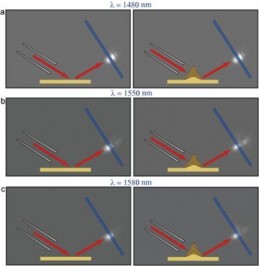Miniature invisibility ‘carpet cloak’ conceals larger area
April 20, 2011

The measured output image from a flat surface (left) and a cloaked protruded surface (right) at 1,480 nm (a), 1,550 nm (b), and 1,580 nm (c) wavelengths (credit: Technical University of Denmark/Optics Express)
Physicists from the Technical University of Denmark (DTU), the University of Birmingham, UK, and Imperial College London, have developed invisibility “carpet cloaks” using metamaterials that can optically conceal a much larger area than other cloaking techniques of comparable size.
The team created an alternating-layer structure on a silicon-on-insulator (SOI) platform. Grating structures, a series of slits or openings that redirect a beam of light, channel light of a particular wavelength around an object. The cloak is made exclusively of dielectric materials, which are highly transparent to infrared light, so the cloak itself is very efficient and absorbs a negligible fraction of energy.
By precisely restoring the path of the reflecting wave from the surface, the cloak creates an illusion of a flat plane for a triangular bump on the surface. This hides its presence over near-infrared wavelengths ranging from 1480 nm to 1580 nm.
“Although our experiment was carried out at near-infrared frequencies, this design strategy is applicable in other frequency ranges,” notes Jingjing Zhang. “We anticipate that with more precise fabrication, our technique should also yield a true invisibility carpet that works in the microwave and visible parts of the spectrum and at a larger size — showing promise for many futuristic defense and other applications.”
Ref.: Jingjing Zhang et al., Homogeneous optical cloak constructed with uniform layered structures, Optics Express, April 19, 2011